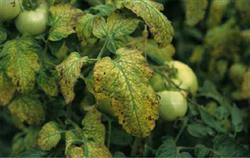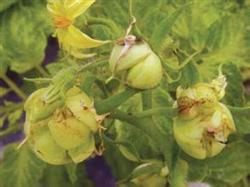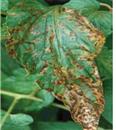Chemical Prevention measures of Tomato spot Wilt virus Disease

After infected with the disease at the seedling stage, the young leaves showed copper curl, there were many black spots on the leaves, the veins on the back of the leaves were purple and green, the stems showed discoloration stripes, the diseased plants grew slowly or dwarfed, deciduous, wilted, atrophied, and the yield decreased. In severe cases, the plant wilted and died directly, this symptom is easily confused with stripe virus. Tomato infected in the fruiting period, the fruit surface appeared green protruding ring spot, the wheel pattern is not obvious, or brown necrotic spot with tumor-like protuberance, which can cause the diseased fruit to fall off. If the fruit is infected when the fruit is ripe, the wheel pattern of the disease spot is obvious, the green spot is the most obvious in the colored period, when the fruit is more serious, the fruit is stiff, the disease spot turns brown and necrotic, and the umbilical symptoms are easily confused with umbilical rot, which should be identified. For tomato spot wilt virus disease, if we can not prescribe the right medicine, it is difficult to get effective prevention and control. Therefore, many vegetable farmers have a headache about tomato spot wilt virus disease. Tomato spot wilt virus disease is transmitted naturally among plant hosts, mainly through piercing or pests, such as aphids, planthoppers and thrips. At the same time, high temperature and drought are also conducive to the disease. Poor management in the field and friction between sick and healthy plants in agricultural operations can also cause disease. At present, there are no direct and effective measures to control the virus, only through the prevention and control of piercing pests, strengthening farming and other measures. In the greenhouse, 15% isoprocarb fumigation is used to kill insects, 250g per mu, and weeds are eradicated at the same time; yellow armyworm boards can be hung for prevention and control, strong seedlings can be cultivated and diseased plants can be pulled out; prick-sucking pests are found after tomato planting, and 1500-fold solution of imidacloprid wettable powder is used to control them in time, or 25% Aketai water dispersible granules can be sprayed to the base of the stem to kill root larvae and pupae. Use 20% morpholine guanidine? Copper 300-fold solution or lentinan 300-fold solution has a certain effect on tomato mosaic virus disease and spot wilt virus disease.
- Prev

How does the tomato appear abnormal fruit to return a responsibility?
Consultation content: how is the malformed fruit of tomato going on? Is it because Baoguoning is not used well? Answer content: Hello! There is a certain relationship between the abnormal fruit of tomato and the improper use of auxin. For example, the concentration used is too high. Dipping time has reached noon, the temperature in the shed is too high, can form deformed fruit.
- Next

Chemical Control of Tomato spot Blight
★ symptoms: tomato spot blight, also known as white star disease. Tomato can occur at all growth stages, infecting leaves, petioles, stems, calyx and fruits. The leaves are infected with water-stained small round spots on the back of the leaves, followed by dark brown edges on both sides of the leaves, gray-white round or near-round slightly sunken spots in the center.
Related
- Where is it suitable to grow horseradish in China? it is expected to see the middle altitude horseradish in Alishan.
- How to prevent tomato virus disease reasonably? (Control methods included)
- Many people like to plant towel gourd on the balcony. What are the main points of this method and management?
- What crops can chili peppers be mixed with?
- Fertilization techniques and matters needing attention in Tomato
- What are the grafting techniques for peach seedlings in spring?
- Harm and control methods of root swelling disease of Chinese cabbage
- What are the pests of sweet potatoes? How to prevent and cure it?
- Symptoms, causes and Control methods of navel Rot in Tomato
- The cause of "Cucumber rotten bibcock" in Farmers' planting Cucumber and its Control Plan

